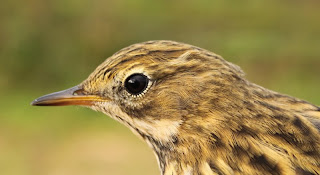My prediction of yesterday that today’s planned ringing might see a recurrence of Chaffinches and Meadow Pipits turned out to be fairly accurate. But I didn’t quite envisage what a true corker of a morning it would turn into with both an excellent, busy ringing session but also a good birding morning packed with variety and interest.
Our first birds of the morning turned out to be owls, with Will hearing the resident Tawny Owl at first light and myself seeing a Little Owl fly from a roadside fence as I approached the Out Rawcliffe farm.
We set our usual quota of nets with the first round timed at 0715 and the last midday. That’s an awful lot of walking when each tour of the nets probably equates to about a half mile trek through rough, long grass. And to think I postponed a gentle swim this morning in favour of a ringing session!
We caught 84 birds, 83 new and 1 recapture as follows; 60 Chaffinch, 14 Meadow Pipit, 2 Goldfinch - both juveniles, 2 Robin, 1 Treecreeper, 1 Dunnock, 1 Jay, 1 Reed Bunting and 1 Blue Tit. The recapture was a Dunnock. The Jay, although a bonny bird, turned out to be an argumentative sort, worth donning a set of gloves to avoid a painful nip or two.
 Reed Bunting
Reed Bunting Goldfinch - Juvenile
Goldfinch - Juvenile Jay
Jay Jay
JayWe pushed our total of Chaffinch ringed here in the last 30 day period to 151 individuals, without a single recapture. Clearly, large numbers of Chaffinch have passed this way recently with the autumn migration starting a little early but yet to peak in mid to late October. Their migration became particularly obvious this morning when we estimated the visible passage as about 90 to 100 birds per hour = approximately 600 birds, with the proportion of those birds caught by us at about 10% of all those visibly heading south in small groups. Of the 60 birds caught 51 were juvenile birds of the year, 13 males and 38 females with the 9 remaining adults split 6/3 in favour of males.
Interestingly the Latin or scientific name for Chaffinch is Fringilla coelebs, which means “bachelor finch”. It received this name about the year 1750 from Linnaeus, the Swedish zoologist who saw that autumn flocks of Chaffinches were often composed of either males or females but that as the winter progressed the small numbers of Chaffinches that remained during the Swedish winter were male birds.
 Adult Male Chaffinch
Adult Male ChaffinchAfter ringing many thousands of Chaffinch over several years we find that ageing them is reasonably easy by a combination of general features, tail shape and the colour of tertial feathers. A glance at the tertial feathers will show whether they are markedly edged bright chestnut in an adult or display more diffuse and paler, even straw or yellowish edges in a younger bird. Females are less obvious than the male shown below, with a duller chestnut colour but the principle still applies. In the picture below the male Chaffinch has both types of tertials and in the second picture below, the tail of a young bird of this year shows how juvenile feathers can wear by September.
 Tertial Feathers - Chaffinch
Tertial Feathers - Chaffinch Tail Feathers, September - Juvenile Chaffinch
Tail Feathers, September - Juvenile ChaffinchOther migration and bird movements were very noticeable this morning with approximately 150 Meadow Pipit heading into the warm southerly wind, 3 Grey Wagtail, 10 “alba” wagtails, 1 Siskin, 5 Corn Bunting, 60+ Goldfinch, 15 Linnet and 45 Skylark. Waders noted were 26 Snipe and 3 Curlew with a single Grey Heron. By 1130 am the continuous movement of Swallows, House Martins and Sand Martins from dawn had built to such an extent that approximately 2000 hirundines, mainly Swallows fed low over the immediate fields and many were still in the area when we left at 1230.
Raptors put in appearances in the form of 1 Sparrowhawk, 3 Buzzard, 2 Kestrel and 1 large Peregrine almost overhead that later came back over us again before diving in pursuit of something behind the birch wood, and whilst I had the wrong lens on for a decent picture, we got some corking views of it.
 Peregrine
Peregrine
















































































